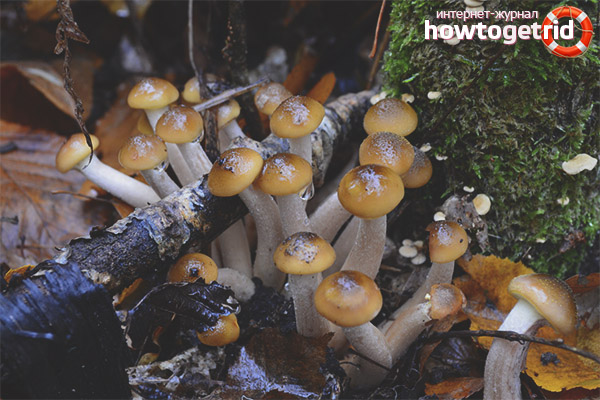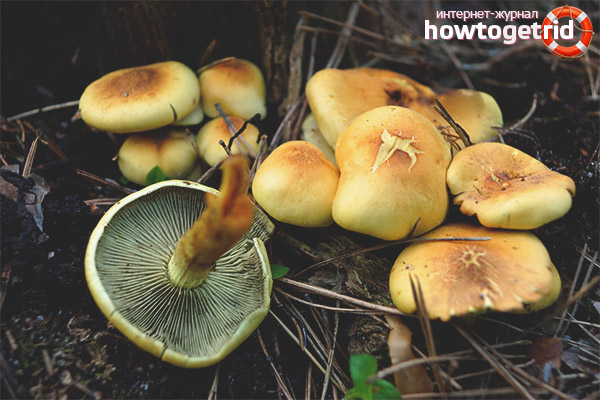The content of the article
Although most types of mushrooms are required to be collected individually, carefully looking for them in the forest more often, nevertheless, there are those that grow in such certain periods of time so dense that in one place the mushroom picker can collect a fairly solid "mushroom" crop. Such species can also include autumn mushroom.
Description, features
Autumn honey agaric - a delicious edible mushroom (a family of fizalakrievye). It has several characteristics characterizing this type of feature, due to which it is possible to distinguish the wrap of the present without difficulty from other species.
- The diameter of the cap is from 30 to 100mm. The shape of the cap in young mushrooms is in the form of a hemisphere, with the growth of the fungus the latter almost straightens out and becomes flat with a wavy border and a tubercle located in the central part. The color of the hat directly depends on the place of distribution and growth conditions and, accordingly, can vary from olive to golden brown with a characteristic greenish tint.
- The number of plates descending over the body of the open legs is relatively small. During the growth of the fungus, the corporal color of the fruit body is replaced by a brownish one.
- Disputes are light (whitish).
- The leg of the honey agaric is continuous (body thickness up to 20 mm), the shape is regular, cylindrical. In length, this part of the fungus grows to 100mm. The color of the legs is light brown with a yellowish tint, in young mushrooms the latter is densely dotted with scales. In the upper part of the leg there is a filmy ring of light color with a yellowish border.
- The cap of mushrooms of this species is rather fleshy, especially for young mushrooms, and its flesh has a very pleasant taste. With the growth of the fungus, the hat becomes darker and thinner, the structure coarsens, the nutritional value decreases.
Species distribution
The presented species of mushrooms is quite widespread, mainly growing in thickets of trees (forested areas with high humidity), in the deadwood and on stumps, which are clearly visible in the dark due to the light emission emanating from the mycelium. To the places where you will not meet Armillaria mellea, you can attribute the area south of the subtropics and permafrost.
The ripening of the fruit body of the autumn honey agaric occurs between August and November. One of the main characteristic features of this edible fungus is fruiting in waves, and the duration of each such wave is from 15 to 25 days. The number of fruiting tides can be about 3 waves in one season. The optimum temperature for mushroom growth, as a rule, does not exceed 10-18 degrees.
Similar and related species
Note that during the fruiting period of the honey agaric, many other mushrooms also grow, characterized by a high similarity to it.
- False foam sulfur-yellow - this mushroom has a yellow-brown color with black plates, there is no membranous ring on the leg, the yellowish pulp has a characteristic unpleasant odor, bitter in taste. This species is very toxic.
- Scaly flake - unlike the edible species, has a larger number of more developed scales. The pulp is quite hard and bitter, the smell is rare. This species is conditionally edible.
- Brick-red honey agaric - this species has a characteristic color and yellowish flesh with a bitter taste. The ring ring on the leg is missing. In the United States and Japan, this species of honey mushrooms is classified as edible mushroom.
- Candol’s false-foam is a mushroom that has a very light color of the hat (cream), and plates of a gray-purple hue, which become darker and more saturated with age. The edibility of this species has not been determined, so its collection during the "mushroom" hunt is not recommended.
- Foam gray-lamellar - a mushroom with a hat of red-brown and yellowish-brown color. The plates are gray-blue, as a rule, the latter become darker, there is no membranous ring on the leg. The flesh of this species is yellowish with a pleasant aroma; it is considered conditionally edible.
- Watery false-froth - a hat of this species of dark brown color, lightening towards the center. The pulp has a bitter taste and is very saturated with moisture. This species is classified as inedible.
Often, mushroom pickers confuse honey agaric with flake flake, the main difference of which is a characteristic increased flake, rare aroma and bitter taste.
Although it is indicated in many sources that the most dangerous double of the autumn honey agaric is sulfur-yellow false foam, nevertheless, the similarity of these species is limited only by the fact that, like real mushrooms, representatives of this species also grow on stumps.
I would like to pay particular attention to the fact that the structure of Armillaria is constantly being reviewed, each mycologist identifies different variants of the species composition of this genus.
Cooking
Each mushroom picker knows very well that autumn mushroom is an edible mushroom that has good taste and pleasant aroma. However, for its preparation required mandatory heat treatment (it is recommended to carry out in two consecutive stages). It is eaten in almost any form: dried, powdered, after frying, boiling, in marinade and cooked by salting.
Mass mushroom harvesting is also carried out, the collection of which is carried out from the end of summer until November, which is then sold at the point of sale in frozen or canned form. Nevertheless, cases of poisoning by this species are not uncommon, as a rule, this is not due to the end of the heat treatment (undercooked mushrooms). Therefore, the processing of mushrooms of this species should be quite lengthy - boil should be cooked for at least 30-40 minutes (initial heat treatment). Only after this is secondary processing of the product carried out, which involves frying, stewing, salting or pickling mushrooms.
View Features
Experts have proved that autumn honey agaric contains a complex of certain substances with a positive antimicrobial and antitumor effect. In addition, the peculiarity of this species is that it copes with the inhibition of gram-positive bacteria such as Staphylococcus aureus.
100 grams of honey mushrooms will provide a person with a daily dose of trace elements such as zinc and copper, which is especially important for the normalization of the processes responsible for blood formation. In addition, these tasty and healthy mushrooms have a positive effect on thyroid function.
That is, it says that honey agarics are not only excellent in taste, but also very useful for human health in general.
The main differences between false and real views
Knowing about the characteristic differences of a forest mushroom from its dangerous double, which can be seriously poisoned, you will never confuse these mushrooms.
- Pay special attention to the color of the mushroom cap. In an edible species, it ranges from beige to dark brown. As a rule, old mushrooms have a darker and more saturated color of the hat. The color of the poisonous double is often brighter, more defiant.
- The second feature that distinguishes the edible and inedible species is the color of the spore of the fungus. Spores of real mushrooms are light, often white, for this reason, on the hats of the old representatives of the species, you can see a characteristic white coating.
- The third symptom is a mandatory check of the fungus for the presence of a membranous ring located on the leg of the mushroom. As a rule, poisonous false feathers do not have such a "skirt". Note that this symptom is the most significant, because thanks to it, edible mushrooms are mainly distinguished from inedible mushrooms.
- The fourth sign that will help to identify a false mushroom in front of you or its edible counterpart is the color of the plates located on the inside of the hat. The color of the plates of inedible species similar to the forest mushroom. It is a characteristic yellowish color (in old mushrooms, greenish-olive). The color of the lamellar structure of the autumn honey agaric is light cream, beige.
- Fifth sign - in real mushrooms, the hat is covered with small scales, while their color is slightly darker than the color of the hat itself. In addition, old mushrooms, as a rule, lose their scales over time, due to which the hat becomes completely smooth. Note that the nutritional value of overgrown, old honey agarics is significantly inferior to the young, for this reason experienced mushroom pickers, as a rule, do not collect them.
- The sixth sign that will help you determine whether you are a real honey agaric or a poisonous double is the smell of a mushroom. Autumn mushrooms have a pleasant "mushroom" flavor. The smell of false duck gives mold.
Knowing the signs that will help distinguish a poisonous mushroom from a forest mushroom will help you collect a good mushroom crop without fearing for the health and life of your loved ones. Nevertheless, when gathering for mushrooms, it is better to bring an experienced mushroom picker with you, who will tell and show you the edible appearance of the mushrooms. Seeing the autumn mushroom with your own eyes, it will be quite difficult for you to confuse it with other mushrooms that differ from it in both appearance and smell, and taste.
Important! When collecting any berries and mushrooms, you always need to follow the well-known rule - "Not sure - don't take it." This will help you enjoy the delicious and healthy gifts of nature without harming your health.
Video: autumn honey agaric (Armillaria mellea)












Submit